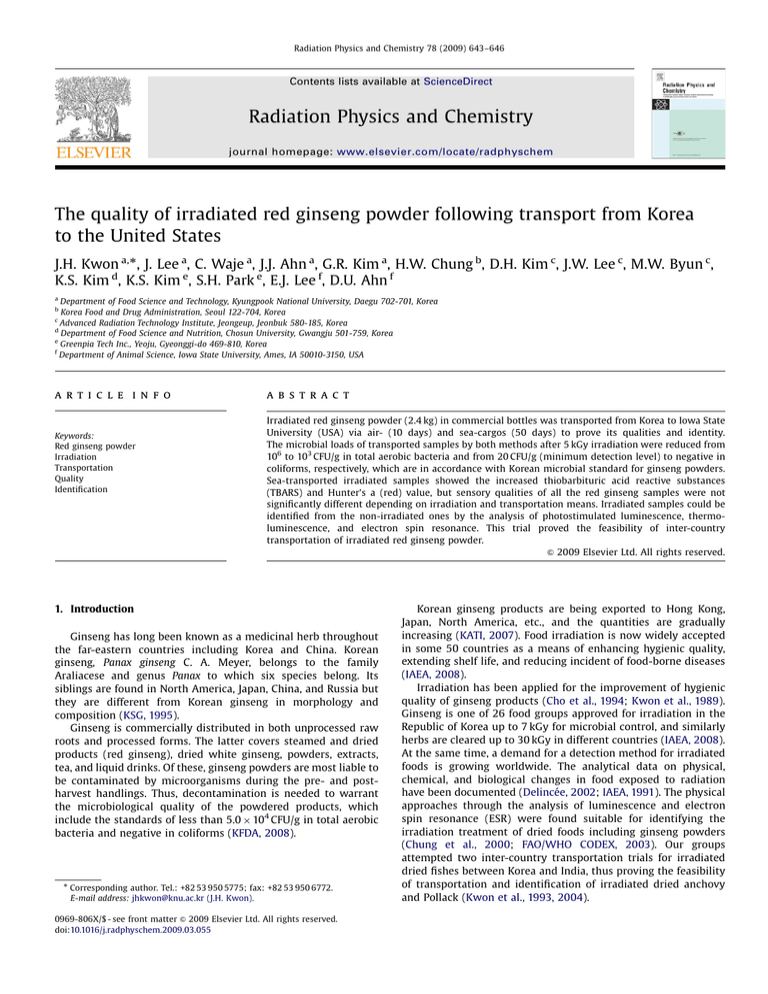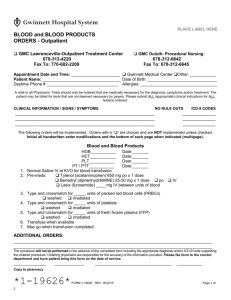
ARTICLE IN PRESS
Radiation Physics and Chemistry 78 (2009) 643–646
Contents lists available at ScienceDirect
Radiation Physics and Chemistry
journal homepage: www.elsevier.com/locate/radphyschem
The quality of irradiated red ginseng powder following transport from Korea
to the United States
J.H. Kwon a,, J. Lee a, C. Waje a, J.J. Ahn a, G.R. Kim a, H.W. Chung b, D.H. Kim c, J.W. Lee c, M.W. Byun c,
K.S. Kim d, K.S. Kim e, S.H. Park e, E.J. Lee f, D.U. Ahn f
a
Department of Food Science and Technology, Kyungpook National University, Daegu 702-701, Korea
Korea Food and Drug Administration, Seoul 122-704, Korea
c
Advanced Radiation Technology Institute, Jeongeup, Jeonbuk 580-185, Korea
d
Department of Food Science and Nutrition, Chosun University, Gwangju 501-759, Korea
e
Greenpia Tech Inc., Yeoju, Gyeonggi-do 469-810, Korea
f
Department of Animal Science, Iowa State University, Ames, IA 50010-3150, USA
b
a r t i c l e in fo
Keywords:
Red ginseng powder
Irradiation
Transportation
Quality
Identification
abstract
Irradiated red ginseng powder (2.4 kg) in commercial bottles was transported from Korea to Iowa State
University (USA) via air- (10 days) and sea-cargos (50 days) to prove its qualities and identity.
The microbial loads of transported samples by both methods after 5 kGy irradiation were reduced from
106 to 103 CFU/g in total aerobic bacteria and from 20 CFU/g (minimum detection level) to negative in
coliforms, respectively, which are in accordance with Korean microbial standard for ginseng powders.
Sea-transported irradiated samples showed the increased thiobarbituric acid reactive substances
(TBARS) and Hunter’s a (red) value, but sensory qualities of all the red ginseng samples were not
significantly different depending on irradiation and transportation means. Irradiated samples could be
identified from the non-irradiated ones by the analysis of photostimulated luminescence, thermoluminescence, and electron spin resonance. This trial proved the feasibility of inter-country
transportation of irradiated red ginseng powder.
& 2009 Elsevier Ltd. All rights reserved.
1. Introduction
Ginseng has long been known as a medicinal herb throughout
the far-eastern countries including Korea and China. Korean
ginseng, Panax ginseng C. A. Meyer, belongs to the family
Araliacese and genus Panax to which six species belong. Its
siblings are found in North America, Japan, China, and Russia but
they are different from Korean ginseng in morphology and
composition (KSG, 1995).
Ginseng is commercially distributed in both unprocessed raw
roots and processed forms. The latter covers steamed and dried
products (red ginseng), dried white ginseng, powders, extracts,
tea, and liquid drinks. Of these, ginseng powders are most liable to
be contaminated by microorganisms during the pre- and postharvest handlings. Thus, decontamination is needed to warrant
the microbiological quality of the powdered products, which
include the standards of less than 5.0 104 CFU/g in total aerobic
bacteria and negative in coliforms (KFDA, 2008).
Corresponding author. Tel.: +82 53 950 5775; fax: +82 53 950 6772.
E-mail address: jhkwon@knu.ac.kr (J.H. Kwon).
0969-806X/$ - see front matter & 2009 Elsevier Ltd. All rights reserved.
doi:10.1016/j.radphyschem.2009.03.055
Korean ginseng products are being exported to Hong Kong,
Japan, North America, etc., and the quantities are gradually
increasing (KATI, 2007). Food irradiation is now widely accepted
in some 50 countries as a means of enhancing hygienic quality,
extending shelf life, and reducing incident of food-borne diseases
(IAEA, 2008).
Irradiation has been applied for the improvement of hygienic
quality of ginseng products (Cho et al., 1994; Kwon et al., 1989).
Ginseng is one of 26 food groups approved for irradiation in the
Republic of Korea up to 7 kGy for microbial control, and similarly
herbs are cleared up to 30 kGy in different countries (IAEA, 2008).
At the same time, a demand for a detection method for irradiated
foods is growing worldwide. The analytical data on physical,
chemical, and biological changes in food exposed to radiation
have been documented (Delincée, 2002; IAEA, 1991). The physical
approaches through the analysis of luminescence and electron
spin resonance (ESR) were found suitable for identifying the
irradiation treatment of dried foods including ginseng powders
(Chung et al., 2000; FAO/WHO CODEX, 2003). Our groups
attempted two inter-country transportation trials for irradiated
dried fishes between Korea and India, thus proving the feasibility
of transportation and identification of irradiated dried anchovy
and Pollack (Kwon et al., 1993, 2004).
ARTICLE IN PRESS
644
J.H. Kwon et al. / Radiation Physics and Chemistry 78 (2009) 643–646
In this study, a third inter-country transportation was tried for
irradiated red ginseng powders in order to determine the effect of
transportation means on their qualities. In addition, some physical
analytical methods were applied to the identification of irradiated
from non-irradiated samples.
2. Experimental
2.1. Sample preparation and transportation
Red ginseng powders (4.8 kg) were purchased from P Ginseng Co.
Ltd. in Gyeongbuk Province, Korea and mixed well for packaging in a
commercial bottle (60 g/bottle). They were divided into 2 groups:
one group was non-irradiated control and the other was irradiated at
5 kGy with 60Co (AECL, IR-79, MDS Nordion International Co. Ltd.,
Ottawa, ON, Canada) at Korea Atomic Energy Research Institute,
Daejon, Korea. The absorbed dose was assured by a ceric/cerous
dosimeter (5.4%). Both irradiated and non-irradiated samples were
divided into two parts for sending one day after irradiation to Iowa
State University (ISU), USA via both transportation methods, air- and
sea-cargos, which reached 10 and 50 days later, respectively. The
transported samples were kept at 471 1C during the evaluation of
qualities and irradiation identification.
2.2. Analysis of quality properties
For the microbiological evaluation, plate count agar and
desoxycholate agar were used for the examination of total
bacterial and coliform counts, respectively (Difco, 1984). Microbial
qualities of transported irradiated and non-irradiated samples by
both methods, air- and sea-cargos, were enumerated one day after
arrival at Iowa State Univ. (USA). Thiobarbituric acid reactive
substances (TBARS) were determined as a lipid quality index (Jo
and Ahn, 2000). The color of red ginseng powder was measured
using a Hunter LabScan Colorimeter (Hunter Laboratory, Inc.,
Reston, VA) by exposing the samples to the illuminant A light
source and the CIE L (lightness), a (redness), and b (yellowness)
values were obtained. The eight sensory panels selected were
trained for color and odor attributes of red ginseng powders. The
panels were asked to make difference in color, odor, and overall
acceptability (OA) of transported irradiated samples using multiple comparison analysis. A reference sample (R) was given to
compare each sample. The sensory score 5 (moderate) was given
to the sample as same as R. The score 1 was for very light in color
or very bad in odor and OA and score 9 was for very dark or very
good (Larmond, 1970).
2.3. Analysis for identification
For the identification of irradiated red ginseng powders from
the non-irradiated one after transportation through sea-cargos
only, photostimulated luminescence (PSL) using a SURRC PPSL
Irradiated Food Screening System (SURRC, Glasgow, UK) (EN
13751, 2002), thermoluminescence (TL) with a TLD system
(Harshaw TLD-4500, Dreieich, Germany) with pure N2 gas
(99.99%) (EN 1788, 2001) and electron spin resonance (JESTE300, Jeol Co., Tokyo, Japan) (EN 1787, 1996) were analyzed. The
PSL signals (photon counts, PCs) were recorded at a rate of counts/
60 s for both the control and irradiated samples. All measurements were done in triplicates.
The data were analyzed using Origin 6.0 (Microcal Software
Inc, Northampton, Mass., USA) (Origin, 1999).
3. Results and discussion
3.1. Microbial, physicochemical and sensory qualities of transported
samples
For both transportation methods for red ginseng powders,
irradiation at 5 kGy reduced the microbial loads from 106 to
103 CFU/g in total aerobic bacteria and from 20 CFU/g (minimum
detection level) to negative in coliforms (Table 1), which are in
accordance with Korean microbial standard for ginseng powders
that include less than 5.0 104 CFU/g in total aerobic bacteria and
negative in coliforms (KFDA, 2008). It was reported that
irradiation was proven very effective for inactivation of
microorganisms contaminated in white ginseng powders
packaged in an air-tight bottle and for keeping the microbial
quality during subsequent 3 months of storage (Kwon et al., 1989).
This result was in good agreement with our previous findings on
microbial quality of the dried anchovies transported from Korea to
India after irradiation at 5 kGy (Kwon et al., 1993).
Both air- and sea-transported irradiated ginseng products
exhibited significantly higher TBARS value than that of the nonirradiated ones. An increase in TBARS value was observed in seacargo samples (Table 2). This finding on the increased TBARS
values in sea-cargo samples was similar to our previous reports on
the sliced-dried Pollack transported from Korea to India after
irradiation at 5 kGy (Kwon et al., 2004). The Hunter’s color values
of both air- and sea-transported red ginseng powders negligibly
changed after irradiation (Table 3). However, a substantial
increase in the a-value (redness) was obtained in sea-cargo red
ginseng powders indicating that the sample became redder after
prolonged transportation.
Table 4 shows the results of sensory evaluation of red ginseng
powders. The color, odor, and overall acceptability of the ginseng
samples were not significantly affected by either irradiation or
inter-country transportation. Our previous findings on the sensory
properties of both inter-country transported dried fishes after
irradiation (Kwon et al., 1993, 2004) and irradiated white ginseng
powders (Kwon et al., 1989) support this result on the transported
red ginseng powders following irradiation.
Table 1
Microbial quality of transported irradiated red ginseng powders from Korea to the
United States.
Transportation method
Microorganisma (CFU/g)
Irradiation dose (kGy)
0
5
Air cargo
Total counts
Coliforms
2.9 106 a
o20
4.2 103 b
0
Sea cargo
Total counts
Coliforms
4.6 106 a
o20
5.8 103 ab
0
a
Mean of three replications (n ¼ 3). Means followed by the same letters in
each row are not significantly different (po0.01).
Table 2
TBARS (mg malonaldehyde/kg)a of transported irradiated red ginseng products
from Korea to the United States.
Transportation method
Air cargo
Sea cargo
Irradiation dose (kGy)
0
5
0.4870.02 b
0.5670.07 b
0.8870.04 a
0.9470.06 a
a
Mean7standard deviation (n ¼ 3). Means followed by the same letters in
each row are not significantly different (po0.01).
ARTICLE IN PRESS
J.H. Kwon et al. / Radiation Physics and Chemistry 78 (2009) 643–646
3.2. Identification properties of transported samples
In order to screen irradiation treatment for the sea-transported
red ginseng powders, the PCs were compared with two thresholds,
the lower threshold (T1, 700 counts/60 s, negative) and upper
threshold (T2, 5000 counts/60 s, positive), even though they are
specific for herbs and spices. (EN 13751, 2002). The PCs of the nonirradiated sample were 435 which were less than the lower
threshold value (T1), while those of 5 kGy-irradiated ones were
1146205 which were higher than the upper threshold (T2),
thus screening them negative (non-irradiated) and positive
(irradiated), respectively, for the transported red ginseng powders
(Table 5).
Table 3
Hunter’s color value of transported irradiated red ginseng products from Korea to
the United States (n ¼ 4).
Hunter parametera
Transportation method
Irradiation dose (kGy)
0
5
L
Air cargo
Sea cargo
75.38
78.19
74.28
78.03
a
Air cargo
Sea cargo
5.40
11.73
5.44
11.17
b
Air cargo
Sea cargo
30.40
31.42
30.35
30.40
DE
Air cargo
Sea cargo
0
0
1.10
1.17
a
Hunter’s parameters: L, degree of whiteness (white +10020 black); a,
degree of redness (red +100280 green); b, degree
of yellowness (yellow
pffiffiffiffiffiffiffiffiffiffiffiffiffiffiffiffiffiffiffiffiffiffiffiffiffiffiffiffiffiffiffiffiffiffiffiffiffi
+70280 blue); and DE, overall color difference ð
645
The minerals separated from the sea-cargo transported red
ginseng powders revealed glow curves (TL1) with very low
intensity at around 200–300 1C in non-irradiated samples, but
with very high intensity between 100 and 250 1C in 5 kGyirradiated samples, which implies the very large differences not
only in the temperature ranges where the peaks appeared but also
in TL signal intensity between irradiated and non-irradiated
samples (Fig. 1, Table 5), which can be used as parameters for
identifying irradiation treatment (EN 1788, 2001; Sanderson et al.,
1998). Also, TL ratios (TL1/TL2), calculated through the
normalization at 1 kGy, were adopted in order to enhance the
reliability of TL1 results (EN 1788, 2001). Table 5 shows the TL
ratios, as a threshold value for the irradiated samples, were 0.017
in non-irradiated sample but 2.285 in irradiated one. These results
on TL ratios were in agreement with the reported TL threshold
values for the non-irradiated o0.1 and irradiated ones 40.1
(EN 1788, 2001; Kwon et al., 2002).
Non-irradiated samples showed ESR signals composed of a
single line with g ¼ 2.006, while irradiated samples at 5 kGy
revealed a triple line with extra signals showing g-values, 2.024,
2.006, and 1.987, which resulted from cellulose radicals on both
sides of the endogenous signal (Fig. 2). These results were similar
to those from the ESR study on kiwi pulp, papayas, tomatoes, and
kiwi core or flesh (De Jesus et al., 1999; Jo and Kwon, 2006) and
indicated that ESR spectroscopic analysis was suitable for
identifying the irradiated red ginseng powder.
4. Conclusions
Irradiated red ginseng powder was transported from Korea to
the USA in order to determine the effect of irradiation at 5 kGy and
DL2 þ Da2 þ Db2 Þ.
2500
Table 4
Means of sensory scorea of transported irradiated red ginseng products from Korea
to the United States.
Irradiation dose (kGy)
Air cargo
Colorb
Odorc
Overall acceptabilityd
Sea cargo
0
5
0
5
5.00 a
5.00 ab
5.00 a
4.94 ab
5.08 a
5.00 a
4.94 ab
5.00 ab
4.94 a
4.90 b
4.94 b
4.94 a
a
Means (n ¼ 8) in the same row followed by different letters are significantly
different (po0.05).
b
Sensory score 5: same as R and moderate color, 1: very light, 9: very dark.
c
Sensory score 5: same as R and moderate odor, 1: very bad, 9: very good.
d
Sensory score 5: same as R and moderate acceptability, 1: very bad, 9: very
good.
2000
TL intensity (a.u.)
Parameter
0 kGy
5 kGy
1500
1000
500
0
0
50
100
150
200
250
300
350
400
450
Temperature (°C)
Fig. 1. TL glow curve of minerals separated from irradiated red ginseng powder.
Table 5
Luminescence properties of irradiated red ginseng powders transported via sea cargos.
Dose (kGy)
Photostimulated–luminescnece
(photon count)
Thermoluminescence
TL1 glow curve
a,b
0
5
435719 ()
11462057950775 (+)
a
b
TL ratio (TL1/TL2)
Glow temp. (1C)
Glow intensity (nC)
200–300
100–250
169.9
2395.0
Means7standard deviation (n ¼ 5).
Threshold value : T1 ¼ 700(non-irradiated), T2 ¼ 5000(irradiated), (): oT1, (M) : T1T2, (+) :4T2.
0.017
2.285
ARTICLE IN PRESS
646
J.H. Kwon et al. / Radiation Physics and Chemistry 78 (2009) 643–646
2000
0 kGy
5 kGy
ESR intensity (a.u.)
1500
1000
500
g2 = 2.006
0
g1 = 2.024
-500
g3 = 1.987
-1000
-1500
6.03 mT
-2000
310
315
320
325
330
335
340
345
Magnetic field (mT)
Fig. 2. Typical ESR spectra of irradiated red ginseng powder.
transportation means, air- and sea-cargos, on its quality and
identification after transportation. Irradiation of red ginseng
powder reduced microbial load after transportation and physicochemical and sensory qualities were not significantly different
from the non-irradiated control. Irradiation treatment could be
easily identified by the analysis of PSL, TL, and ESR. This trial
proved the feasibility of inter-country transportation of irradiated
red ginseng powder.
References
Cho, H.O., Byun, M.W., Kang, I.J., Youk, H.S., Kwon, J.H., 1994. Improvement of
hygienic quality of white ginseng powder by gamma irradiation. Radioisotopes
43, 750–759.
Chung, H.W., Delincée, H., Kwon, J.H., 2000. Photo stimulated luminescence–thermoluminescence application to detection of irradiated white ginseng power.
Korean J. Food Sci. Technol. 32, 265–270.
De Jesus, E.F.O., Rossi, A.M., Lopes, R.T., 1999. An ESR study on identification of
gamma-irradiated kiwi, papaya and tomato using fruit pulp. J. Food Sci.
Technol. 34, 173–178.
Delincée, H., 2002. Analytical methods to identify irradiated food-a review. Radiat.
Phys. Chem. 63, 455–458.
Difco, 1984. Dehydrated culture media and reagents for microbiology. In: Difco
Manual, 10th ed., Difco, Detroit, MI.
EN 1787, 1996. Foodstuffs—detection of irradiated food containing cellulose, method
by ESR spectroscopy. European Committee for Standardization, Brussels, Belgium.
EN 1788, 2001. Foodstuffs—detection of irradiated food from which silicate
minerals can be isolated, Method by thermoluminescence. European Committee for Standardization, Brussels, Belgium.
EN 13751, 2002. Foodstuffs—detection of irradiated food using photostimulated
luminescence. European Committee for Standardization, Brussels, Belgium.
FAO/WHO CODEX, 2003. General codex methods for the detection of irradiated
foods, CODEX STAN 231-2001, Rev.1.
IAEA, 1991. Analytical detection methods for irradiated foods, a review of current
literature, IAEA-TECDOC-587, 1–172.
IAEA, 2008. International Atomic Energy Agency Homepage, Clearance of
Irradiated Food Database /http://www.iaea.org/icgfi/data.htmS.
Jo, C., Ahn, D.U., 2000. Volatiles and oxidative changes in irradiated pork sausage
with different fatty acid composition and tocopherol content. J. Food Sci. 65,
270–275.
Jo, D.J., Kwon, J.H., 2006. Detection of radiation-induced markers from parts of
irradiated kiwifruits. Food Control 17, 617–621.
KATI, 2007. Korea Agricultural Trade Information. /http://www.kati.co.krS.
KFDA, 2008. Korean Health Functional Food Code, Korea Food and Drug
Administration, Seoul, Korea, 51–52.
KSG, 1995. Understanding of Korean Ginseng, The Korean Society of Ginseng, Seoul,
Korea, 35–54.
Kwon, J.H., Bélanger, J.M.R., Paré, J.R.J., 1989. Effects of ionizing energy treatment on
the quality of ginseng products. Radiat. Phys. Chem. 34, 963–967.
Kwon, J.H., Byun, M.W., Warrier, S.B., Kamat, A.S., Alur, M.D., Nair, P.M., 1993.
Quality changes in irradiated and nonirradiated boiled-dried anchovies after
intercountry transportation. J. Food Sci. Technol. 30, 256–260.
Kwon, J.H., Jeong, J.Y., Lee, E.Y., Jo, D., Noh, J.E., Lee, J.E., 2002. Multiple detection to
identify irradiated brown rice of different origins. Food Sci. Biotechnol. 11,
215–219.
Kwon, J.H., Kausar, T., Noh, J.E., Warrier, S.B., Venugopal, V., Karani, M., Artik, A.,
Bhushan, B., Byun, M.W., Kim, S.J., Kim, K.H., Kim, K.S., 2004. Inter-country
transportation of irradiated dried Korean fish to prove its quality and identity.
Radiat. Phys. Chem. 71, 83–87.
Larmond, E., 1970. Methods for sensory evaluation of food. Canada Department of
Agriculture, 5–30 (Publication 1284).
Origin, 1999. Origin tutorial manual, Version 6.0, Microcal Software Inc., Northampton, MA, 20–45.
Sanderson, D.C.W., Carmichael, L.A., Fisk, S., 1998. Establishing luminescence
methods to detect irradiated foods. Food Sci. Technol. Today 12, 97–102.


